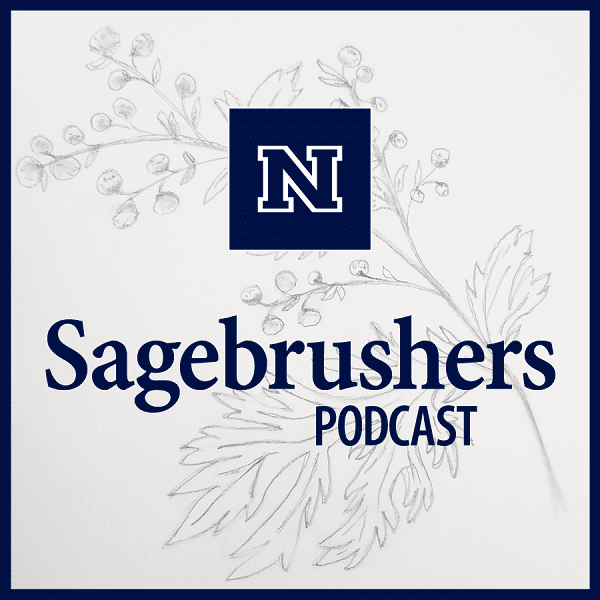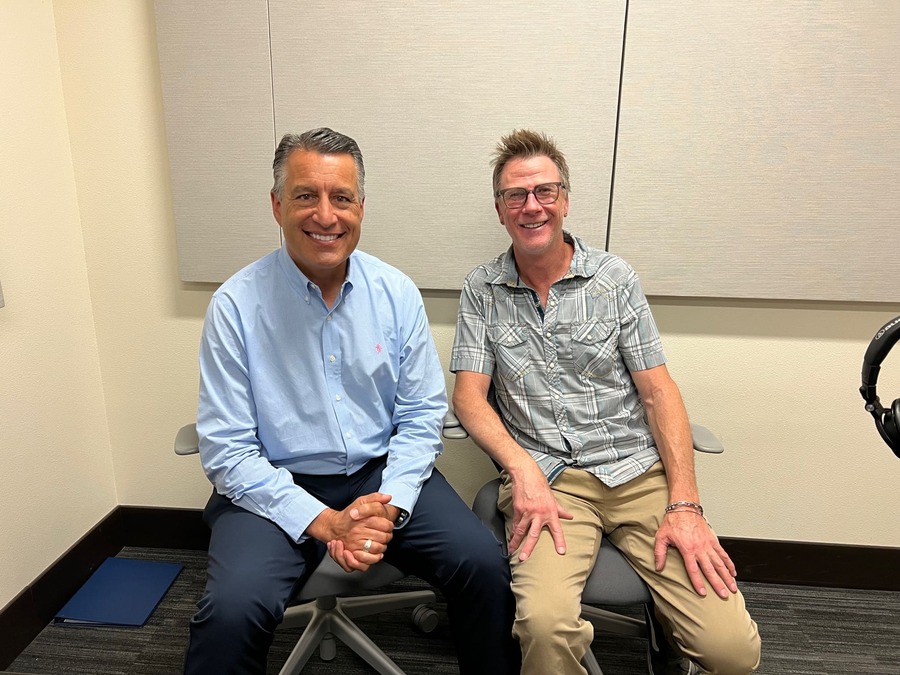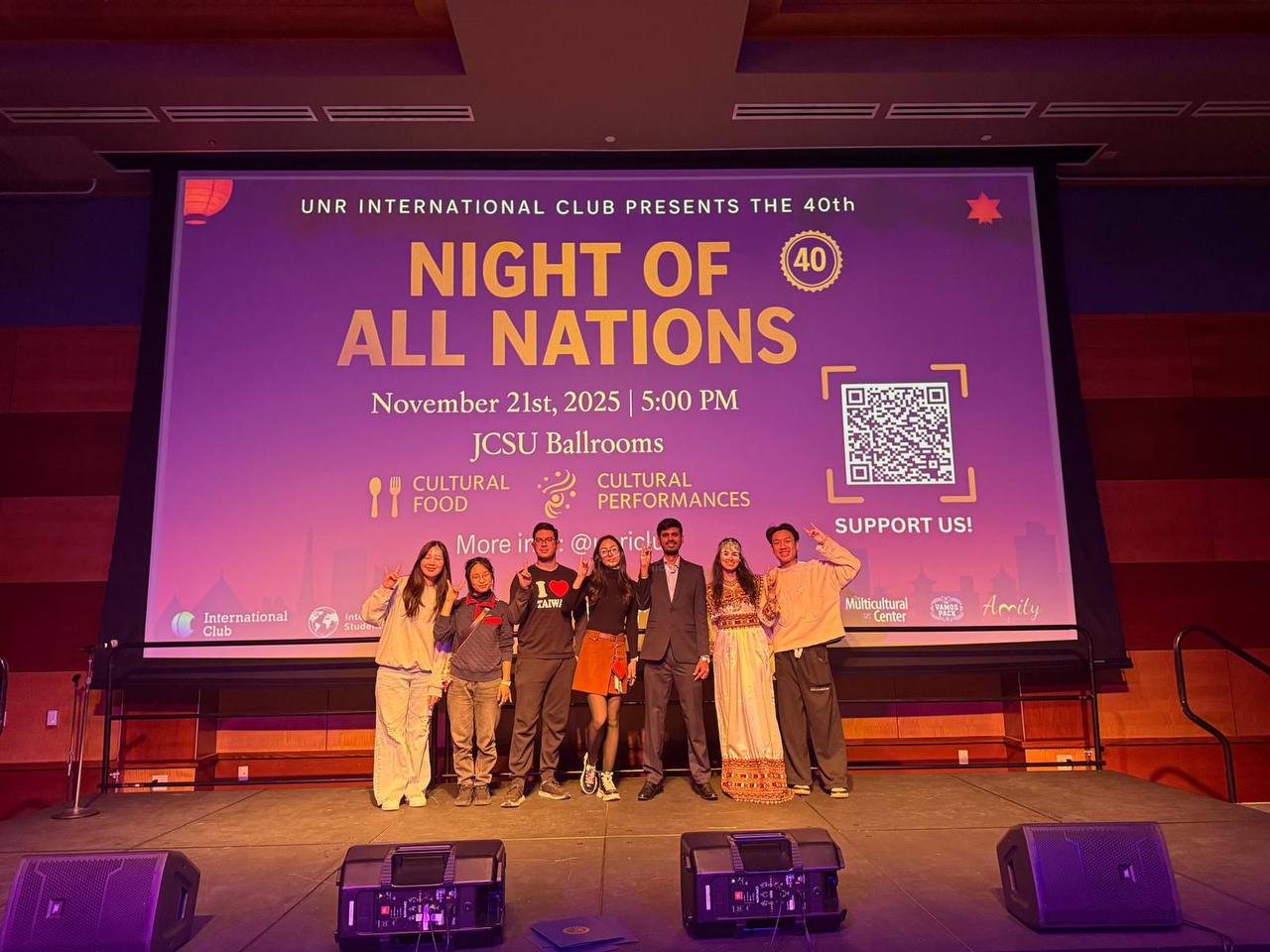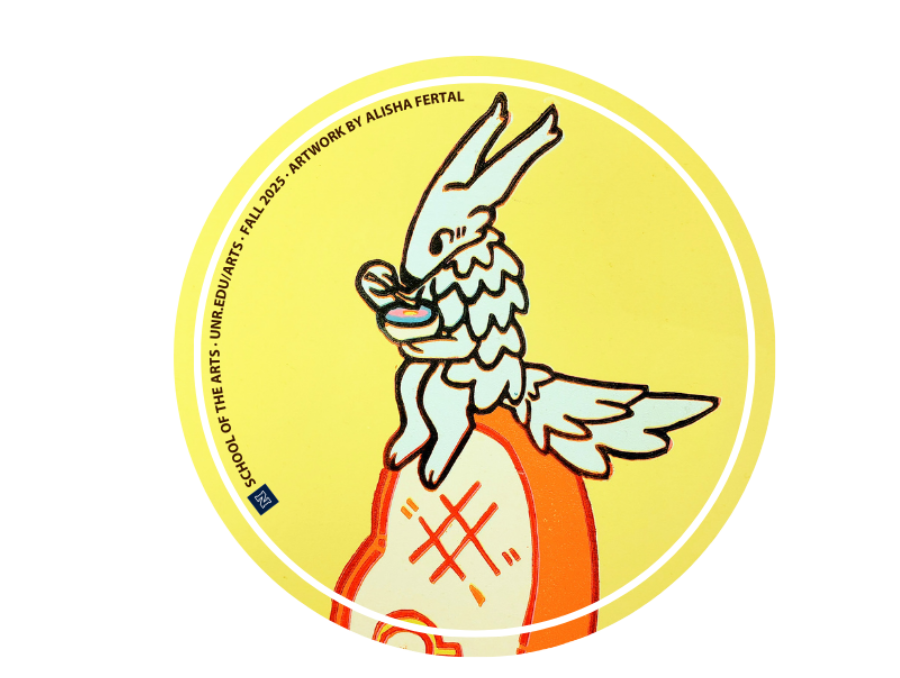
University of Nevada, Reno President Brian Sandoval chats with Rick Parsons, director of the Holman Arts & Media Center located at the University’s Wayne L. Prim Campus, in Sagebrushers season 2 episode 13. Parsons, who also serves as the director of the Summer Arts Workshops, is a sculptor whose work has been showcased around the country.
During the episode, Sandoval and Parsons talk about the Holman Arts & Media Center, a recently remodeled space that allows students and faculty to work on projects in a variety of mediums including pottery, sculpture and 3D printing. They also discuss the Summer Arts Workshops, hosted on the Prim Campus throughout the summer for members of the public to attend. In addition, Parsons shares his passion for incorporating environmental sustainability and stewardship into his teaching. This episode was recorded in the summer of 2023.
Sagebrushers is available on Spotify, Apple Podcasts and other major podcast platforms, with new episodes every month.
Sagebrushers – S2 Ep. 13 – Rick Parsons
Join host President Brian Sandoval as he and Rick Parsons, director of the Holman Arts & Media Center located at the University’s Wayne L. Prim Campus, discuss the Summer Arts Workshops, teaching about art and environment and more.
Rick Parsons: I'm a firm believer that we all have the ability to make great art. All we have to do is give it form. We have the ideas innate in us. We just haven't been allowed to express ourselves in that way. And my goal is to give people an opportunity to express themselves in that way.
President Brian Sandoval: In this episode of Sagebrushers, we welcome Rick Parsons, director of the Holman Arts and Media Center at the University of Nevada, Reno at Lake Tahoe. I'm Brian Sandoval. I'm a proud graduate and president of the University, and I'm your host of Sagebrushers.
Originally from Galveston, Texas, Rick is a sculptor whose work has been exhibited throughout the country and has been featured in national publications, books and documentaries. In addition to his role with Holman Arts and Media Center, Rick is the director of Summer Arts Workshops at our Lake Tahoe location. Prior to the acquisition, Rick taught at Sierra Nevada University for 13 years and was named the 2013 and 2021 faculty member of the year by the SNU student body. Previously, Rick held the position of sculpture program coordinator at Anderson Ranch Arts Center and taught at both the University of Dallas and Colorado Mountain College.
Today's podcast is being recorded at the Reynolds School of Journalism on our University's campus. Rick, welcome to Sagebrushers. I'm really excited and look forward to learning more about you and the great work you're doing at our Lake Tahoe location. So welcome.
Parsons: Thanks, President Sandoval, for having me here. It's great to be here.
Sandoval: Oh, this is going to be a really good conversation. So, let's start with this. You've been in Lake Tahoe for some time now, and I'm curious, how did you end up teaching art?
Parsons: Ended up teaching art right out of grad school. I went to University of Dallas and was quickly invited to start teaching at an all-girl Catholic high school in Dallas, Ursuline Academy, and started teaching ceramics and sculpture there and taught there for about three years. Then was invited back to where I went to graduate school to teach a sabbatical replacement, and that kind of kicked me into, the higher ed world of teaching.
Sandoval: That's, that's fantastic. So, we're going to move on, but just by way of background, and most of our listeners know this is, that in the last couple years, Sierra Nevada University was acquired by the University of Nevada Reno, and now we have the University of Nevada Reno at Lake Tahoe. And I will say, as an aside, probably the most beautiful campus in the United States, if not the world, that it's just spectacular. As part of the University of Nevada, Reno, Lake Tahoe and formerly Sierra Nevada University, there is the Holman Arts and Media Center. So first, Rick, talk about the Holman Arts and Media Center and what an incredible gem it is.
Parsons: Yeah, the Holman Arts and Media Center was a great shift that happened at Sierra Nevada University. We had some great donors, Robert Holman, that had donated the building to us and helped us renovate that building. And it pretty much quadrupled the space that we're working in and really allowed us to do some things that we weren't doing in the past. Spread out a little bit. It's a beautiful building, well lit, light from all directions in the space. It's just really incredible.
Sandoval: No, it is beautiful. But just as beautiful as it is on the outside, it's even more beautiful on the inside. So, talk about the creativity that happens within the Holman Arts Center.
Parsons: The Holman Arts Building, we approached it with the theory of having an open design and being very interdisciplinary. So, of kind of breaking down the silos within the art world. Technique can sometimes divide a building up, and what we wanted to do is create a space that had rolling walls that we could open up that space. You could hear each discipline having discussions about their work and their practice. And what we're trying to do is make more fluid space and intellectually more fluid that you'd have more crossover between disciplines.
Sandoval: So, I've been there a few times and I hope someday I have time to take a class there, but, you know, I was really overwhelmed by the sculpture, the ceramics, the things that can be created there. So, will you talk a little bit about that?
Parsons: Yeah. Within the space, we have I think six or seven electric kilns, a large reduction kiln for doing high-fire functional ceramics. You also can put large sculpture in those kilns. We also have laser cutters and maker bots for 3D printing and other things. And Chris Lanier, one of our faculty up there, teaches a drone class. So, we like getting our students outside and into the environment. And a lot of our classes have a component of the class always ends up outside in the field and really thinking about the environment and trying to bring the environment into the studio or taking the students out into the environment.
Sandoval: So also, you know, the Holman Arts Center is immediately adjacent to the campus. So, it's, it's very accessible. And for years now, and even this summer, there are Summer Arts Workshops, and as I said, there's a long history there. So, will you talk about that history and, you know, I understand you're teaching one of those classes now. So, if I were somebody that was enrolled in that class, what could I look forward to?
Parsons: Well, you're going to look forward to meeting a nice group of diverse people coming from all over the country. It's a nationally known program. It's been running for 39 years. Sheri Lee O'Connor, who is a professor of emeritus here at UNR, really brought that program to light in the national light and has grown that program. I've taken that over now and running those workshops. And we're bringing in a lot of people that have been here in the past and we're trying some new things from time to time. You could learn from plein air painting. We just had Phyllis Shafer who's shown here on campus, and UNR has produced a book for Phyllis Shafer. She just did a plein air painting class. They were out at Sand Harbor painting on the beach while all the tourists were running around, looking over their shoulder. Some incredible paintings, ceramics classes. Right now, we have a laser-cutting class going on. Next week we'll do a beginning wheel throwing. Sheri Lee O'Connor and myself are teaching that class. We have Arthur Gonzalez coming in from the Bay Area who does a figurative workshop. He can teach anybody how to make figurative ceramic work. And he does it the strange way. He does it inside out. He flips, he'll push and flip the thing inside out and make a face and it's magic watching him work.
Sandoval: Well, I want to come, but will you talk about wheel throwing? What is wheel throwing?
Parsons: Wheel throwing is, is using a potter's wheel. It has a motor on it. It spins about 20 miles an hour, maybe a little faster at times. You throw a piece of clay on the wheel head, you center that clay by pushing on it, and then you slowly open that into a form, a hollow form. So, most pottery that you see is made that way when it's handmade. The potters wheel is a really interesting, unique tool. It's kind of like wood turning but for clay.
Sandoval: So, I was up there, I don't know if it was a year ago or so, but I walked in and I saw you and said hello. And we talked a little bit about this before we went on air, but you were making skateboards. Talk a little bit about that.
Parsons: Yeah, we have a class that's dedicated to, it's pretty much a sculpture class, but the sculpture techniques are hidden in the skateboard design itself, or actually it's interdisciplinary in a sense. They have to use Adobe Illustrator, so they're learning Photoshop and Illustrator and those things, and they come up with a design. Then we use the laser cutter to cut out their designs that they've made on the computer, and then we laminate quarter-inch plywood together to get up to half inch, and then we mount wheels on it and there's etched-in images, words or whatever they wanted to do. So, they have their own personal longboards for cruising around Incline Village.
Sandoval: And, and they're out and about using them.
Parsons: They are out and about using it. That's the nerve-wracking day is when they put the wheels on.
Sandoval: I bet.
Parsons: I make them wear helmets.
Sandoval: Yeah. Okay. That's good. I wasn't going to ask that. No, and as I said I think, I'm just really impressed with the variety of offerings that you have up there. And, you know, there also is somewhat of a residential program that you're, you're doing right now. Will you talk a little bit about that?
Parsons: The Summer Arts Workshops are pretty incredible. They run from nine to five; they take an hour break for lunch; we treat it like a job. So, they're showing up, spending all day, and they can see what it feels like to be a studio artist and spend their time doing that and dedicated to one thin during the day. We kind of look at that one-week workshop and it's almost about a half semester's worth of work crammed into a week.
Sandoval: Wow. So, if I were to enroll in that class, and I have no background in art whatsoever, I'll come out of it having made something or created something, correct?
Parsons: Yeah. You'll just need a nice apron if you take my will throw in class. You'll get a little dirty. You get your hands dirty. It's, and it's a nice way to kind of figure out how things are done. Most people don't know how things are made anymore. We just, we consume those things, and we don't ever know how they're fabricated. So just taking one of those classes makes you more aware of the objects around you and yeah, we can teach you how to throw and make you a coffee mug, but be careful. You have to make everybody a coffee mug on campus, which is, it's a lot of coffee mugs.
Sandoval: We'll call it the Sandoval mug. So, let's, you know, you've talked a little bit about the environment. So how do you incorporate the environment into the classes you teach at the University of Nevada, Reno at Lake Tahoe?
Parsons: Yeah. So, we have this approach up there where we kind of limp into technique, like we like to have a theme to our courses. So, we'll start with a theme. It could be water, could be the environment, A ceramics class that I teach, the students go and dig up clay in the Carson Valley. We bring that clay back up from the Genoa area. We process it, so there's the science part of it and firing it at different temperature, seeing what it can do. And once, well, you can figure out what the clay can do, then we can make something with that. So, some clays are better at glazes or being slips. Some are better at clay bodies for building the form. So, what they have to do is figure out first what can they do with the clay. And then they have to make something. Their final ends up being a final project using that material.
The great thing is that I don't put any parameters on it. So, if they're interested in glazes, I would say, let's push that clay that you found to a glaze. If they're more interested in sculpture, and I'd say, okay, we need to make a clay body. We might have to add other materials to that clay to get it to a point where they can make something out of it. Then I've had other students that aren't interested in the firing of that material, and they use it more like an Adobe or Adobe brick or do drawings with it, with that material.
Sandoval: No, I'm sure you see some very interesting things that come from your students.
Parsons: Well, the goal is to keep it open and so their personality can come out and that it's not just about technique. It's really about what they see and how they perceive the world and using that material to show that and let them have a voice.
Sandoval: So, you must see a change in some people even after that week.
Parsons: Oh, it's great. First of all, a lot of the students, if they're early into art, they've never made anything before in their life besides coloring books or doing some sketches in a sketch pad or on inside their history book or something. So, getting them and saying, “Hey, you can make something.” I'm a firm believer that we all have the ability to make great art. All we have to do is give it form. We have the ideas innate in us. We just haven't been allowed to express ourselves in that way. And my goal is to give people an opportunity to express themselves in that way. Either as undergraduate students, as a lot of the Summer Arts Workshop students are an older demographic, and what I'm trying to do right now is to diversify the demographic in the Summer Arts Workshops to get more blending there so the conversation can be more deep that, you have a younger perspective and an older perspective coming together.
Sandoval: Well, and I suppose that's one of the things I'd like to emphasize in this podcast is that for the summer of ‘24, anybody can take a class with you, correct?
Parsons: It's open to all, every class is open to all, and we have some classes that there's a lot of intermediate students. And then I have some classes that are getting all the way to advanced and our faculty are ready. They're pros at what they do. A lot of them have been teaching in higher ed for years and doing their own personal practice for a long time so they can plug in and help people. I also have studio coordinators, I have Julia Hart and Molly Allen working with me to help facilitate that. So, if a faculty member is caught in one area, then we can run over and help that person if they're a beginner. So, it's really high touch.
Sandoval: That's great. Now you mentioned faculty, so how have you been able to engage with faculty across disciplines, including the university faculty here in Reno and the sciences, and why are these types of collaborations valuable?
Parsons: Yeah, I'm a true believer of interdisciplinary thought and practice and looking at something from multiple perspectives. I think, deconstructing something with three perspectives is better than deconstructing something with one perspective and trying to understand that thing. So, this fall we have a class coming up with Sudeep Chandra and Molly Allen. Molly's going to be teaching a drawing class, and Sudeep is going to be sitting in. They're going to be using data and data points from around the lake to generate images, also using natural materials from the environment to create pigments to draw with. So that's one example. We also have our galleries up there that are open to the community. We have the Tahoe Gallery, which is in the Prim Library, and we also have the Garage Door Gallery, which is in the Holman Arts and Media building.
And we are currently, we have two artists working. One Josh Reed, who's in the music department here at UNR Reno, and then Emily Ward Bivens, who is from University of Tennessee, Knoxville. She is an interdisciplinary multidisciplined artist within the arts. And we have Josh, who is a jazz musician, working together to create a piece for the Tahoe Gallery, the same time that Classical Tahoe's going on. So, they've gone out and captured sound and video, and Josh is doing pedal manipulation of the sounds that we've captured in the Tahoe Basin. And they're right now constructing a piece that will be presented in a couple weeks.
Sandoval: Wow. That's all I have to say is wow. And that's why we're so excited about this Semester at Tahoe that our students are going to be able to have, because they're going to be exposed, you know, to classes, to faculty, to learning that you just can't find anywhere else. So, we're coming up on time, but I have one more question for you. Protecting and preserving Lake Tahoe, the gem of the Sierra, is central to the mission of the University of Nevada, Reno at Lake Tahoe. So how do you think art can inspire environmental stewardship and sustainability?
Parsons: Yeah, the, the arts are an opportunity to, to showcase something and, and share something. And artists have a unique perspective when they look at something and they can see the detail and the minutiae that's happening in an environment. I grew up in Galveston, Texas, as you mentioned, and the petrochemical industry and what was done to Galveston Bay is pretty amazing. I mean, multiple EPA sites all around where I grew up, and I come up to Lake Tahoe and I just look at the purity and I have this innate need to protect and preserve and talk about it. And I think the more that people see it in any form that's photography, painting, somebody inspired by nature that makes a sculpture will help preserve that. And I think the arts are really important in creating a different vision of a space. Classical Tahoe's up there. Now, hearing the sounds or this other sound that kind of makes you more aware of that environment while that's happening. So, all that stuff's amazing to me. The lake is so inspiring and seeing the colors and the subtleties of that space is amazing. And the more people we can get up there, the more we can protect it and the more people that will want to protect it.
Sandoval: No, and I want to thank you for, you know, being here of course today, but just how you open students' eyes to what you just talked about. And Lake Tahoe is a special place, and I often say if, if I had a vision of what heaven looked like, it would be like Tahoe. And so, it really is a truly special place, and for the University to have a campus there and to have somebody of your passion and dedication and devotion, both to the environment as well as students in learning and education is just phenomenal. So, thank you for what you do.
Parsons: Thank you.
Sandoval: So, unfortunately, that is all the time we have for this episode of Sagebrushers. And again, Rick, thank you again for joining us, and please join us next time for another episode of Sagebrushers as we continue to tell the stories that make our University special and unique. Until then, I'm University President Brian Sandoval and go Pack.















